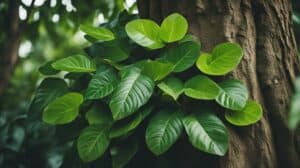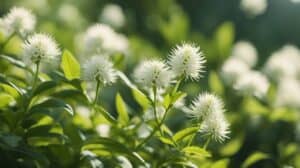Angraecum sesquipedale, also known as the Star of Madagascar orchid, is a fascinating and unique plant that has captured the attention of botanists and orchid enthusiasts around the world.
This orchid is native to Madagascar and is known for its striking appearance, with long, slender petals that extend up to a foot in length.
However, what makes this orchid truly remarkable is its relationship with a specific species of moth.

The story of the Angraecum sesquipedale and its relationship with the Xanthopan morganii praedicta moth is a fascinating one.
In the 19th century, Charles Darwin predicted the existence of a moth with a proboscis long enough to pollinate the orchid’s deep floral tube.
It wasn’t until years later that the moth was actually discovered, proving Darwin’s theory to be correct.
This discovery was a significant moment in the history of evolutionary biology and has led to further research on the co-evolution of plants and pollinators.
Today, the Angraecum sesquipedale remains a popular orchid species among collectors and enthusiasts.
Its unique appearance and fascinating history make it a fascinating subject for study and appreciation.
Origin and Habitat
Angraecum sesquipedale, commonly known as the Star of Madagascar Orchid, is a fascinating species of orchid that is endemic to Madagascar.
It was first discovered by the French botanist Louis-Marie Aubert du Petit-Thouars in the early 19th century.
Geographic Distribution
The Star of Madagascar Orchid is found exclusively in the eastern and northwestern regions of Madagascar, an island nation located off the coast of Africa.
It is one of the most widely distributed orchid species in Madagascar, and can be found in a variety of habitats, including rainforests, montane forests, and coastal forests.
Natural Habitat
The Star of Madagascar Orchid thrives in a warm and humid environment, and is often found growing on the trunks and branches of trees.
It is an epiphytic orchid, which means that it grows on other plants without harming them.
The orchid’s roots attach themselves to the bark of the host tree, and the plant absorbs nutrients and moisture from the air and rain.
In addition to its natural habitat, the Star of Madagascar Orchid is also cultivated in greenhouses and private gardens around the world.
Despite its popularity among orchid enthusiasts, the species remains vulnerable in the wild due to habitat loss and over-collection.
Conservation efforts are underway to protect this unique and beautiful orchid from extinction.
Botanical Description

Angraecum sesquipedale, commonly known as the Star of Madagascar orchid, is a fascinating and unique species of orchid that is native to Madagascar.
This orchid is known for its long and slender spur that extends from the back of the flower.
Flower Characteristics
The flowers of Angraecum sesquipedale are large and showy, with a pure white color and a waxy texture.
The petals are broad and rounded, while the sepals are narrow and elongated.
The most distinctive feature of this orchid is its long spur, which can measure up to 30 centimeters in length.
The spur is curved and slender, and it hangs down from the back of the flower.
This unusual feature has led to the orchid’s nickname, the Star of Madagascar, as it is said to resemble a shooting star.
Plant Morphology
Angraecum sesquipedale is a epiphytic orchid, which means that it grows on other plants or trees.
The plant has a compact growth habit, with a stem that can reach up to 30 centimeters in length.
The leaves are dark green and leathery, and they grow in an alternating pattern along the stem.
The roots of this orchid are thick and fleshy, and they are used to anchor the plant to its host.
Overall, Angraecum sesquipedale is a beautiful and unique species of orchid that is sure to capture the attention of any plant enthusiast.
Its long spur and pure white flowers make it a standout in any collection, and its compact growth habit makes it easy to care for and maintain.
Cultivation and Care

Growing Conditions
Angraecum sesquipedale, also known as the Star of Madagascar orchid, is a stunning plant that requires specific growing conditions to thrive.
This species is native to Madagascar, where it grows in the humid forests of the island.
To replicate these conditions, the orchid should be grown in a warm and humid environment.
The ideal temperature range for this orchid is between 70°F and 85°F, and the humidity level should be around 60%.
The Star of Madagascar orchid prefers bright, indirect light, and it should be protected from direct sunlight.
If the light is too intense, the leaves may turn yellow and the plant may suffer.
It is recommended to place the orchid near a window that receives morning or evening light.
Propagation Methods
Propagation of Angraecum sesquipedale can be achieved through several methods, including division, seed propagation, and tissue culture.
Division is the most common and straightforward method, and it involves separating the plant into smaller pieces and repotting them into individual containers.
Seed propagation requires more patience and skill, as it can take up to several years for the plant to reach maturity.
Tissue culture is a more advanced method that involves growing the plant in a laboratory using a sterile culture medium.
Regardless of the propagation method, it is important to provide the newly propagated plants with the same growing conditions as the parent plant to ensure their success.
Overall, with proper care and attention, the Star of Madagascar orchid can be a rewarding addition to any orchid collection.
Conservation Status

Threats
Angraecum sesquipedale is facing several threats to its survival. One of the major threats is habitat loss due to deforestation, mining, and agriculture.
The orchid’s natural habitat in Madagascar is rapidly disappearing due to human activities.
In addition, the orchid is also threatened by illegal collection for the horticulture trade.
The demand for this orchid in the international market is high, and this has resulted in over-collection from the wild.
Conservation Efforts
Several conservation efforts are being made to protect Angraecum sesquipedale from extinction.
The orchid is listed under Appendix I of the Convention on International Trade in Endangered Species of Wild Fauna and Flora (CITES), which prohibits international trade of the species.
Madagascar has also designated the orchid as a protected species under its national laws.
In addition, several botanical gardens and conservation organizations are working to conserve the orchid in their collections and in the wild.
Efforts are also being made to restore the orchid’s habitat through reforestation and habitat restoration programs.
Several research programs are also underway to study the ecology and biology of the orchid, which will help in developing effective conservation strategies.
Despite these efforts, Angraecum sesquipedale remains a critically endangered species, and urgent action is needed to protect it from extinction.
Frequently Asked Questions

How do you care for the Star of Madagascar orchid?
The Star of Madagascar orchid, or Angraecum sesquipedale, requires bright but indirect light and high humidity to thrive.
It is important to keep the soil moist but not waterlogged, and to fertilize regularly during the growing season.
The plant should be repotted every two years to ensure healthy growth.
What specific conditions are needed to grow Angraecum sesquipedale successfully?
In addition to bright but indirect light and high humidity, Angraecum sesquipedale requires temperatures between 60-80°F and good air circulation.
It is also important to use a well-draining potting mix and to avoid overwatering.
Can you explain the unique relationship between the Star of Madagascar orchid and its pollinator?
The Star of Madagascar orchid is known for its unique relationship with the hawkmoth, which is the only known pollinator of the plant.
The orchid’s long nectar spur, which can reach up to 12 inches in length, is thought to have evolved to specifically attract the moth’s long proboscis.
The moth’s tongue is just long enough to reach the nectar at the bottom of the spur, and in the process of feeding, the moth picks up and deposits pollen from the orchid’s flowers.
Where can one purchase Angraecum sesquipedale plants?
Angraecum sesquipedale can be purchased from specialty orchid nurseries or online retailers.
It is important to purchase plants from a reputable source to ensure healthy and disease-free specimens.
What are the distinct characteristics of the Angraecum sesquipedale flower?
The Angraecum sesquipedale flower is white with a long nectar spur that can reach up to 12 inches in length.
The flower has a star-shaped appearance, with narrow petals and a prominent lip.
The plant typically blooms in the winter months and can produce multiple flowers on a single spike.
How does Angraecum sesquipedale differ from other Angraecoid orchids?
Angraecum sesquipedale is known for its unique relationship with the hawkmoth, which is not found in other Angraecoid orchids.
Additionally, the plant’s long nectar spur is a distinguishing characteristic that sets it apart from other orchid species.














